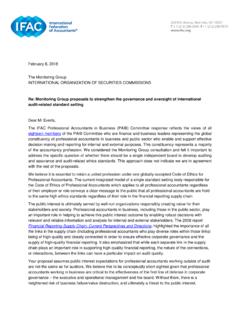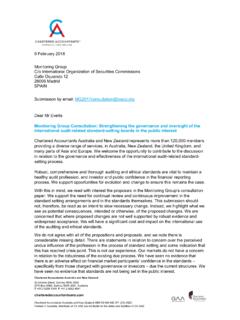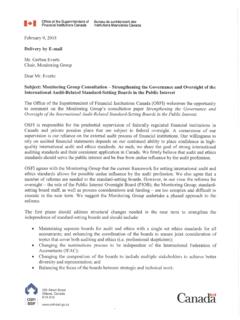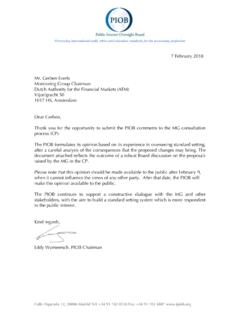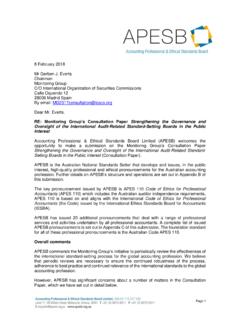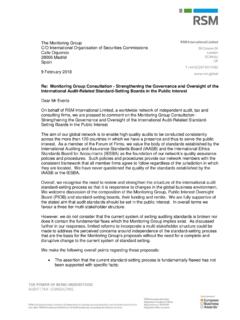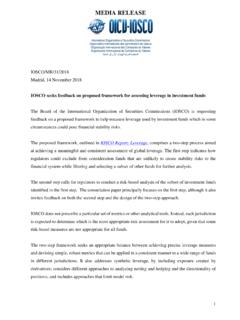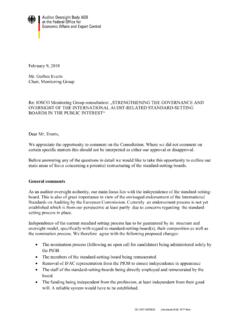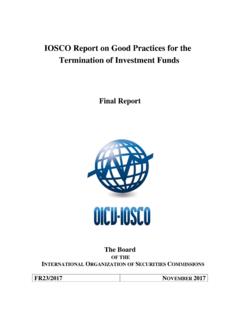Transcription of Principles for Financial Benchmarks - IOSCO
1 Principles for Financial Benchmarks Final Report THE BOARD OF THE INTERNATIONAL ORGANIZATION OF SECURITIES COMMISSIONS FR07/13 JULY 2013 ii Copies of publications are available from: The International Organization of Securities Commissions website International Organization of Securities Commissions 2013. All rights reserved. Brief excerpts may be reproduced or translated provided the source is stated. iii Foreword The Board of the International Organization of Securities Commissions ( IOSCO ) has published this Final Report. This Report, which has been prepared by the IOSCO Board Level Task Force on Financial Market Benchmarks (Task Force), sets out IOSCO s final Principles on Financial Benchmarks . This report also summarizes and discusses the comments received on a Consultation Report: Principles for Financial Benchmarks ,1 published by IOSCO on 16 April 2013.
2 Key terms are defined in the Glossary in Annex A. Contents Chapter Page 1. Introduction 1 2. The Principles for Financial Benchmarks 9 3. Discussion of Consultation Feedback 30 Annex A Glossary of Terms 35 B Feedback Statement 38 C Guidance on Principle 9 Transparency of benchmark 44 1 See CR04/13 Principles for Financial Benchmarks , Consultation Report, The Board of IOSCO , 16 April 2013, available at: 1 Chapter 1 Introduction Background On 16 April 2013 the International Organization of Securities Commissions published a Consultation Report: Principles for Financial Benchmarks2 (April Consultation Report), which requested comments from the public on proposed final Principles for Financial Benchmarks . The Principles were developed by IOSCO s Board Level Task Force on Financial Market Benchmarks .
3 The IOSCO Board created the Task Force in light of investigations and enforcement actions regarding attempted manipulation of major interest rate Benchmarks3. Those investigations and enforcement actions raised concerns over the fragility of certain Benchmarks in terms of both their integrity and their continuity of provision - that has the 2 Principles for Financial Benchmarks , IOSCO , April 2013, supra fn No 1 3 Japan Financial Services Agency (JFSA) took administrative action against RBS Securities Japan Limited (12 April 2013): US Commodity Futures Trading Commission (CFTC) Order against UBS AG and UBS Securities Japan Co. Ltd to pay a $700 million penalty to settle charges of manipulation, attempted manipulation and false reporting of certain global benchmark interest rates (19 December 2012): and UK Financial Services Authority (FSA), fined UBS AG 160 million for significant failings in relation to the London Interbank Offered Rate (LIBOR) and the Euro Interbank Offered Rate (EURIBOR) (19 December 2012: and Swiss Financial Market Supervisory Authority (FINMA) ordered UBS AG to disgorge CHF 59 million in profits to the Swiss Confederation for seriously violating Financial market legislation in connection with the submission of interest rates, particularly LIBOR (19 December 2012): US CFTC Order against Barclays PLC, Barclays Bank PLC and Barclays Capital Inc.)
4 To pay a $200 million penalty for attempted manipulation of and false reporting concerning LIBOR and EURIBOR (27 June 2012): and UK FSA fined Barclays Bank PLC million for misconduct relating to LIBOR and EURIBOR (27 June 2012): and JFSA took administrative action against UBS Securities Japan Ltd and UBS AG, Japan branches, (16 December 2011): JFSA took administrative action against Citigroup Global Market Japan Inc. (16 December 2011): JFSA took administrative action against Citibank Japan Ltd. (16 December 2011): 2 potential to undermine market confidence potentially harming both investors and the real economy. The April Consultation Report was informed by the comments received to IOSCO s initial Consultation Report in January 2013 (January Consultation Report),4 as well as by comments received at stakeholder meetings on 21 February 2013 at the Financial Services Authority (FSA) (the predecessor organisation to the UK Financial Conduct Authority (FCA) in London and on 26 February 2013 at the US Commodity Futures Trading Commission (CFTC).)
5 During the course of this work, the Task Force also has taken into consideration the related work undertaken within a variety of regulatory and industry fora. These include: Regulatory Work streams: The IOSCO Principles for Oil Price Reporting Agencies (PRA Principles ) which was undertaken by IOSCO Committee 7 on Commodity Futures Markets; Significant reviews of domestic interbank Benchmarks , notably the CFTC UBS Order, the CFTC Barclays Order 5and FSA Order, and The Wheatley Review of LIBOR: final report;6 The European Commission s Consultation on the Regulation of Indices;7 The European Securities and Markets Authority/European Banking Authority s Principles for benchmark -Setting Processes in the EU;8 and The Bank for International Settlements Board of Governors Economic Consultative Committee Industry Work streams: 4 CR01/13 Financial Benchmarks : Consultation Report, Report of the IOSCO Board 10 Jan.
6 2013: 5 See Principles for Financial Benchmarks , IOSCO , April 2013, supra fn No 1 6 The Wheatley Review of LIBOR: Final Report (Sept 2012): 7 European Commission, consultation document on The Regulation of Indices: a Possible Framework for the Regulation of the Production and Use of Indices serving as Benchmarks in Financial and other Contracts (5 September 29 November 2012): 8 European Securities and Markets Authority (ESMA) and European Banking Authority (EBA), Principles for Benchmarks -Setting Processes in the EU, ESMA/2013/658 (5 June 2013 : +ESMA-EBA+ Principles +on+ Benchmarks +Final + 9 See press release: and Bank for International Settlements report Towards better reference rate practices: a central bank perspective (18 March 2013): 3 Best practice standards for conducting benchmark price assessments issued by the Global Financial Markets Association (GFMA);10 and The proposal by Argus Media, ICIS and platts for a price reporting code for independent price reporting agencies (IPRO).)
7 11 Objective of IOSCO s Work on Benchmarks As stated in the January Consultation Report, IOSCO s objective is to create an overarching framework of Principles for Benchmarks used in Financial markets12. Specifically, the IOSCO Board seeks to articulate policy guidance and Principles for benchmark -related activities that will address conflicts of interest in the benchmark -setting process, as well as transparency and openness when considering issues related to transition. To inform this work, IOSCO s Task Force initially reviewed a selection of Benchmarks , representing a number of asset classes in different jurisdictions. That review, as well as IOSCO s consideration of benchmark issues in the context of oil price reporting agencies and in work being conducted in other fora, helped identify certain broad, generic risks to the credibility of Benchmarks arising from vulnerabilities in the Benchmarks Methodology, transparency and governance As discussed in both consultation reports, these risks arise from incentives stemming from conflicts of interests, which may be amplified when Expert Judgement is used in benchmark determinations.
8 The following factors should be taken into account when assessing the risk of a benchmark : 1. Submissions to Benchmarks : As described in the January Consultation Report, there are a variety of methods by which different forms of data are developed, collected and transmitted to Administrators. The Submission process may create additional vulnerabilities to the determination process if not addressed by appropriate controls and policies. For example, there may be conflicts of interests in and incentives to manipulate the determination process where the Submitters are also Market Participants with stakes in the level of the Benchmarks . Furthermore, there may be other conflicts of interests and opportunities for manipulative conduct created by the possibility of voluntary and/or selective Submissions, the varied composition of Submitters, and discretion in the selection of data to be submitted.
9 2. Content and transparency of Methodologies: If the procedures and policies concerning the Methodology do not contain adequate detail, the ability of Stakeholders to evaluate 10 Global Financial Markets Association (GFMA), Principles for Financial Benchmarks (November 2012) and GFMA Updated Principles for Financial Benchmarks (November 2012) 11 The Price Reporting Code for Independent Price Reporting Organizations (Draft) 30 April 2012: 12 CR01/13 Financial Benchmarks , Consultation Report, IOSCO , 10 Jan. 2013, supra fn 4. 13 See Id. at Appendix B. As stated in the January 2013 Consultation Report at , IOSCO s Task Force did not make recommendations relating to any given benchmark 4 the credibility of a benchmark may be restricted. Furthermore, a lack of transparency may allow abusive conduct to influence benchmark determinations.
10 Low transparency in the absence of strong internal controls may also create opportunities for gaming Submissions to influence a benchmark . 3. Governance processes: The enforcement cases reviewed by the Task Force illustrate that conflicts of interest at both the Submitter and Administrator levels can create incentives for abusive conduct. These conflicts can arise within the variety of structures that may exist in the benchmark Submission and compilation processes. For example, Submitters, Administrators, Calculation Agents or other third parties may attempt to manipulate a benchmark by submitting false or misleading data or by attempting to influence personnel at the Administrator level who are responsible for the exercise of Expert Judgment. The final Principles have been developed, and should be read collectively, to address these vulnerabilities.

